Lost in the Google +1 button launch and Schema.org announcement was the release of a new version of Google Scribe. In typical Google fashion, this unassuming product may be more important than both Google +1 and Schema.org.
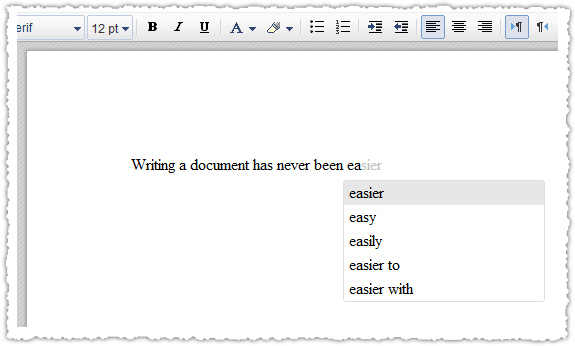
What is Google Scribe?
Google Scribe is one of a number of Google Labs experiments.
Google Scribe helps you write better documents. Using information from what you have already typed in a document, Google Scribe’s text completion service provides related word or phrase completion suggestions. It also checks your documents for incorrect phrases, punctuations, and other errors like misspellings. In addition to saving keystrokes, Google Scribe’s suggestions indicate correct or popular phrases to use.
Think of it as an intelligent version of Google Docs.
Language Research Lab
But what is Google Scribe really about? Look no further than the engineer working on the project.

That’s right, Google Scribe is about language models, something at the core of how Google interprets and evaluates web content.
Since Google Scribe’s first release on Google Labs last year, we have been poring over your feedback and busy adding the top features you asked for. Today, we’re excited to announce a new version of Google Scribe that brings more features to word processing.
Poring over your feedback might seem like they’re reading comments and suggestions submitted by users, but in actuality I’m guessing it’s the complex analysis of usage. Google Scribe is about language research. The kind of research helping Google refine algorithmic signals.
Every time you use Google Scribe you’re helping to refine the language model by choosing from one of many text completion suggestions. Google is getting smarter about language.
Semantic Proofreading
One of the new features seems to be a direct result of this analysis: semantic proofreading.
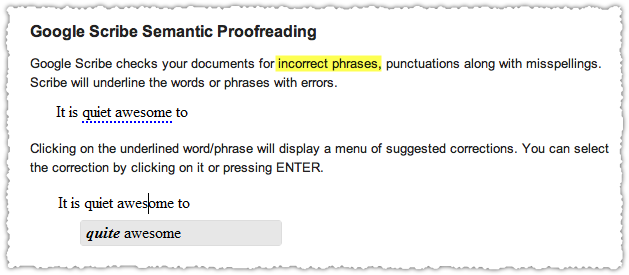
Normal spell check would not catch the words in this example because both words are correctly spelled. Yet, the language model has learned that the word awesome is rarely ever preceded by the word quiet.
That’s quite awesome.
Good Writing Matters
Unless you’ve been living under a rock you probably know that Google is using spelling and grammar as a way to determine content quality. Any analysis of Amit Singhal’s Panda questions would indicate that grammar and spelling are gaining in algorithmic importance.
I’d recently discussed Google’s potential use of spelling and grammar on reviews with Bill Slawski. I wasn’t convinced it was a good idea.
But then Barry Schwartz reported on a Google Webmaster Forum response by Google employee John Mueller regarding spelling in user generated content.
This was noteworthy enough to prompt an official Google tweet.
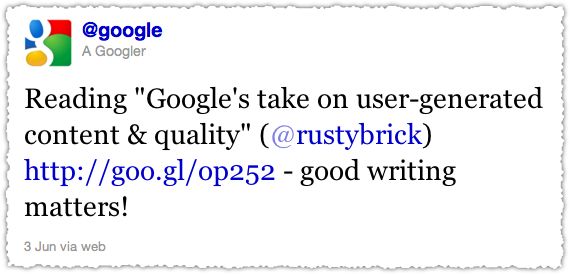
Is that clear enough for you?
Anchor Text Suggestions
This new version of Google Scribe creates automatic anchor text for a URL. That in itself is pretty interesting, but Google Scribe also gives alternate anchor text suggestions and the ability for the user to create their own.
Here are two examples using my fellow Sphinn editors: Michael Gray and Jill Whalen.
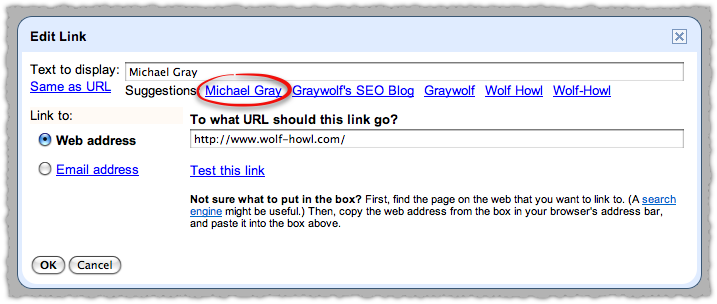
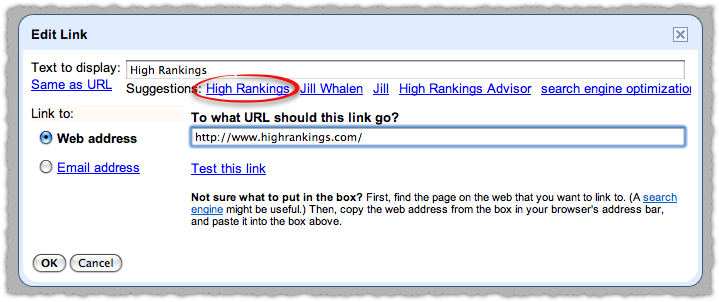
Clearly Google Scribe is already seeing and using back link profiles. But Google will learn about the validity of the anchor text every time someone changes the anchor text from the automated, or primary suggestion, to one of the other suggestions or creates something entirely new.
What happens when Google Scribe determines that the primary suggestion for a URL is rarely used? The implication is that link suggestions could provide a feedback mechanism on overly optimized or ‘off-topic’ anchor text.
In other words, a paid link signal.
High Quality Documents
I’m convinced Google Scribe is helping to improve Google’s ability to interpret and analyze language. But there are indications that Google could be thinking even bigger.
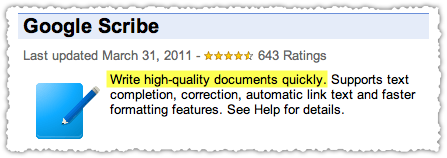
Sure enough the description of Google Scribe starts with that succinct elevator pitch. “Write high-quality documents quickly.” The last word tells me it’s meant to support the new digital content work flow.
Scribe Bookmarklet and Extension
You can take Google Scribe on the go using the bookmarklet or Chome extension. I’m using the bookmarklet right now as I’m writing this post.

It’s a bit clunky from a UX perspective but I see a lot of potential. A more refined product might help sites ensure their users are producing well written user generated content.
Flipping The Funnel
Why limit yourself to the output of content when you can influence the input of content.
The explosion of digital content has been made possible, in large part, by blogging platforms. Yet, the quality of the content has been uneven, and that’s probably being generous. So why not attack the problem at the top of the funnel? Help people write better content.
I like the idea. In fact, I like it so much I’m exploring a side project that does the same thing in a different yet complementary way.
Google Scribe and SEO

Like it or not, Google is using spelling and grammar to determine content quality. Google Scribe is one method being used by Google to better understand and evaluate language and anchor text. It’s not about the actual product (right now) but about the data (feedback) Google Scribe is producing.
Instead of obsessing about the specifics of the Panda update the SEO community can look to Google Scribe and take the hint. It’s not just what you say, it’s also how you say it.
So if you’re responsible for content, take a few more minutes and proofread your work. Google will.
The Next Post: Google Related Searches
The Previous Post: Mechanical Turk Tips

1 trackbacks/pingbacks
Comments About Google Scribe SEO Hints
// 5 comments so far.
Bill Rowland // June 06th 2011
Really interesting stuff. I suppose that it only makes sense that there’s a big push to improve content quality and cleaning it up at the point of creation is probably the easiest time to do it.
Damn, now I have to improve my spelling…
aj // June 06th 2011
Thanks Bill. Panda was the start of an on-going effort to better identify high-quality content. But there’s no reason to think they’re going to stop there.
Maybe Google won’t flip the funnel but with Page at the helm they might be willing to think big again.
Aaron Bradley // June 06th 2011
What a great post, AJ. I love that you’ve uncovered a method of actually being able to (to some extent) plug in some textual data and produce a Google-eyed view of the “quality,” both at it pertains to that text and anchor text generation. More useful by far than simply wringing one’s hands about how Google might or might not favor a web page in the post-Panda world.
aj // June 06th 2011
Thanks Aaron.
It is interesting to see what Google predicts and what types of grammar and phrases it considers. I wish I’d used it more when it first launched to see how much the suggestions have or haven’t changed. But really it’s the process that interests me and makes me believe that Google is doubling down on cracking the language problem and seeing if the same process can help them better parse organic versus manufactured anchor text.
M. Edward (Ed) Borasky // June 06th 2011
This is interesting indeed! Any chance the folks at WordPress can build me something like this? 😉
Sorry, comments for this entry are closed at this time.
You can follow any responses to this entry via its RSS comments feed.